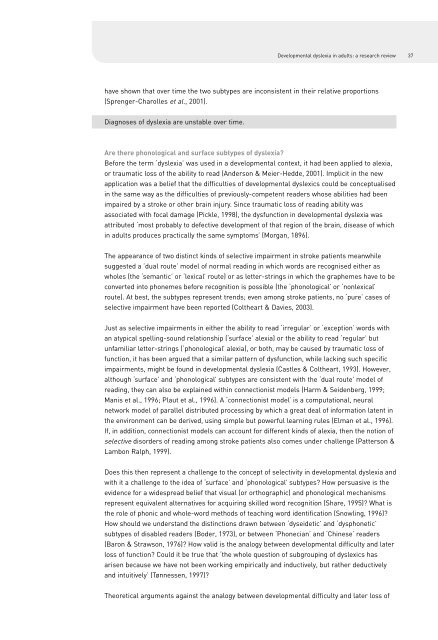01 NRDC Dyslexia 1-88 update - Texthelp
01 NRDC Dyslexia 1-88 update - Texthelp
01 NRDC Dyslexia 1-88 update - Texthelp
Create successful ePaper yourself
Turn your PDF publications into a flip-book with our unique Google optimized e-Paper software.
Developmental dyslexia in adults: a research review 37<br />
have shown that over time the two subtypes are inconsistent in their relative proportions<br />
(Sprenger-Charolles et al., 20<strong>01</strong>).<br />
Diagnoses of dyslexia are unstable over time.<br />
Are there phonological and surface subtypes of dyslexia?<br />
Before the term ‘dyslexia’ was used in a developmental context, it had been applied to alexia,<br />
or traumatic loss of the ability to read (Anderson & Meier-Hedde, 20<strong>01</strong>). Implicit in the new<br />
application was a belief that the difficulties of developmental dyslexics could be conceptualised<br />
in the same way as the difficulties of previously-competent readers whose abilities had been<br />
impaired by a stroke or other brain injury. Since traumatic loss of reading ability was<br />
associated with focal damage (Pickle, 1998), the dysfunction in developmental dyslexia was<br />
attributed ‘most probably to defective development of that region of the brain, disease of which<br />
in adults produces practically the same symptoms’ (Morgan, 1896).<br />
The appearance of two distinct kinds of selective impairment in stroke patients meanwhile<br />
suggested a ’dual route’ model of normal reading in which words are recognised either as<br />
wholes (the ‘semantic’ or ‘lexical’ route) or as letter-strings in which the graphemes have to be<br />
converted into phonemes before recognition is possible (the ‘phonological’ or ‘nonlexical’<br />
route). At best, the subtypes represent trends; even among stroke patients, no ‘pure’ cases of<br />
selective impairment have been reported (Coltheart & Davies, 2003).<br />
Just as selective impairments in either the ability to read ‘irregular’ or ‘exception’ words with<br />
an atypical spelling-sound relationship (‘surface’ alexia) or the ability to read ‘regular’ but<br />
unfamiliar letter-strings (‘phonological’ alexia), or both, may be caused by traumatic loss of<br />
function, it has been argued that a similar pattern of dysfunction, while lacking such specific<br />
impairments, might be found in developmental dyslexia (Castles & Coltheart, 1993). However,<br />
although ‘surface’ and ‘phonological’ subtypes are consistent with the ‘dual route’ model of<br />
reading, they can also be explained within connectionist models (Harm & Seidenberg, 1999;<br />
Manis et al., 1996; Plaut et al., 1996). A ‘connectionist model’ is a computational, neural<br />
network model of parallel distributed processing by which a great deal of information latent in<br />
the environment can be derived, using simple but powerful learning rules (Elman et al., 1996).<br />
If, in addition, connectionist models can account for different kinds of alexia, then the notion of<br />
selective disorders of reading among stroke patients also comes under challenge (Patterson &<br />
Lambon Ralph, 1999).<br />
Does this then represent a challenge to the concept of selectivity in developmental dyslexia and<br />
with it a challenge to the idea of ‘surface’ and ‘phonological’ subtypes? How persuasive is the<br />
evidence for a widespread belief that visual (or orthographic) and phonological mechanisms<br />
represent equivalent alternatives for acquiring skilled word recognition (Share, 1995)? What is<br />
the role of phonic and whole-word methods of teaching word identification (Snowling, 1996)?<br />
How should we understand the distinctions drawn between ‘dyseidetic’ and ‘dysphonetic’<br />
subtypes of disabled readers (Boder, 1973), or between ‘Phonecian’ and ‘Chinese’ readers<br />
(Baron & Strawson, 1976)? How valid is the analogy between developmental difficulty and later<br />
loss of function? Could it be true that ‘the whole question of subgrouping of dyslexics has<br />
arisen because we have not been working empirically and inductively, but rather deductively<br />
and intuitively’ (Tønnessen, 1997)?<br />
Theoretical arguments against the analogy between developmental difficulty and later loss of
















